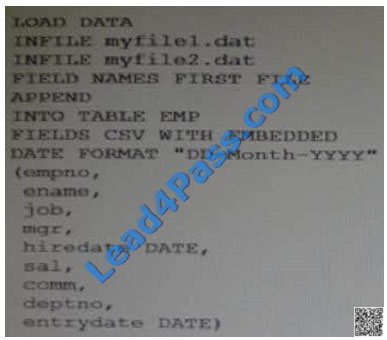What is the best way to pass the Oracle 1Z0-061 exam? (First: Exam practice test, Second: leads4pass Oracle expert.) You can get free Oracle Database 1Z0-061 exam practice test questions here.
Or choose https://www.leads4pass.com/oracle-database.html Study hard to pass the exam easily!
Oracle Database 1Z0-061 Exam Video
Table of Contents:
- Latest Oracle Database 1Z0-061 google drive
- Effective Oracle 1Z0-061 exam practice questions
- Related 1Z0-061 Popular Exam resources
- leads4pass Year-round Discount Code
- What are the advantages of leads4pass?
Latest Oracle Database 1Z0-061 google drive
[PDF] Free Oracle Database 1Z0-061 pdf dumps download from Google Drive: https://drive.google.com/open?id=1vEGzoBKjFNXljPLuvJOwmAYwHNAZx7Qu
Upgrade to Oracle Database 12c | Oracle University:https://education.oracle.com/upgrade-to-oracle-database-12c/pexam_1Z0-061
Latest updates Oracle 1Z0-061 exam practice questions
QUESTION 1
On your Oracle 12c database, you Issue the following commands to create indexes
SQL > CREATE INDEX oe.ord_customer_ix1 ON oe.orders (customers_id, sales_rep_id) INVISIBLE;
SQL> CREATE BITMAP INDEX oe.ord_customer_ix2 ON oe.orders (customers_id, sales_rep_id);
Which two statement are correct?
A. Both the indexes are created; however, only the ORD_COSTOMER index is visible.
B. The optimizer evaluates index access from both the Indexes before deciding on which index to use for query
execution plan.
C. Only the ORD_CUSTOMER_IX1 index is created.
D. Only the ORD_CUSTOMER_IX2 index is created.
E. Both the indexes are updated when a new row is inserted, updated, or deleted In the orders table.
Correct Answer: AE
11G has a new feature called Invisible Indexes. An invisible index is invisible to the optimizer as default. Using this
feature we can test a new index without effecting the execution plans of the existing sql statements or we can test the
effect of dropping an index without dropping it.
QUESTION 2
You are about to plug a multi-terabyte non-CDB into an existing multitenant container database (CDB) as a pluggable
database (PDB).
The characteristics of the non-CDB are as follows: Version: Oracle Database 12c Releases 1 64-bit
Character set: WE8ISO8859P15
National character set: AL16UTF16
O/S: Oracle Linux 6 64-bit
The characteristics of the CDB are as follows: Version: Oracle Database 12c Release 1 64-bit
Character set: AL32UTF8
O/S: Oracle Linux 6 64-bit
Which technique should you use to minimize down time while plugging this non-CDB into the CDB?
A. Transportable database
B. Transportable tablespace
C. Data Pump full export / import
D. The DBMS_PDB package
E. RMAN
Correct Answer: D
Note:
* Generating a Pluggable Database Manifest File for the Non-CDB Execute the dbms_pdb.describe procedure to
generate the manifest file.
exec dbms_pdb.describe(pdb_descr_file=>\\’/u01/app/oracle/oradata/noncdb/noncdb.xml\\’);
Shut down the noncdb instance to prepare to copy the data files in the next section.
shutdown immediate exit
QUESTION 3
Which four actions are possible during an Online Data file Move operation? (Choose four.)
A. Creating and dropping tables in the data file being moved
B. Performing file shrink of the data file being moved
C. Querying tables in the data file being moved
D. Performing Block Media Recovery for a data block in the data file being moved
E. Flashing back the database
F. Executing DML statements on objects stored in the data file being moved
Correct Answer: ACDF
QUESTION 4
What is the result of executing a TRUNCATE TABLE command on a table, in a non-CDB database, that has Flashback
Archiving enabled?
A. It fails with the ORA-665610 Invalid DDL statement on history-tracked message
B. The rows in the table and the archive are truncated, and flashback archiving is disabled.
C. The rows in the table are truncated without being archived.
D. The rows in the table are archived, and then truncated.
E. The rows in both the table and the archive are truncated.
Correct Answer: D
http://surachartopun.com/2010/06/ddl-on-tables-enabled-for-flashback.html
QUESTION 5
Examine the contents of SQL loader control file:
Which three statements are true regarding the SQL* Loader operation performed using the control file?
A. An EMP table is created if a table does not exist. Otherwise, if the EMP table is appended with the loaded data.
B. The SQL* Loader data file myfile1.dat has the column names for the EMP table.
C. The SQL* Loader operation fails because no record terminators are specified.
D. Field names should be the first line in the both the SQL* Loader data files.
E. The SQL* Loader operation assumes that the file must be a stream record format file with the normal carriage return
string as the record terminator.
Correct Answer: ABE
A: The APPEND keyword tells SQL*Loader to preserve any preexisting data in the table. Other options allow you to
delete preexisting data, or to fail with an error if the table is not empty to begin with.
B (not D): Note:
* SQL*Loader-00210: first data file is empty, cannot process the FIELD NAMES record Cause: The data file listed in the
next message was empty. Therefore, the FIELD NAMES FIRST FILE directive could not be processed.
Action: Check the listed data file and fix it. Then retry the operation
E:
*
A comma-separated values (CSV) (also sometimes called character-separated values, because the separator
character does not have to be a comma) file stores tabular data (numbers and text) in plain-text form. Plain text means
that the
file is a sequence of characters, with no data that has to be interpreted instead, as binary numbers. A CSV file consists
of any number of records, separated by line breaks of some kind; each record consists of fields, separated by some
other
character or string, most commonly a literal comma or tab. Usually, all records have an identical sequence of fields.
*
Fields with embedded commas must be quoted.
Example:
1997,Ford,E350,”Super, luxurious truck”
Note:
*
SQL*Loader is a bulk loader utility used for moving data from external files into the Oracle database.
QUESTION 6
On your Oracle Database, you issue the following commands to create indexes:
SQL > CREATE INDEX oe.ord_customer_ix1 ON oe.orders (customer_id, sales_rep_id) INVISIBLE;
SQL> CREATE BITMAP INDEX oe.ord_customer_ix2 ON oe.orders (customer_id, sales_rep_id);
Which two statements are true?
A. Only the ORD_CUSTOMER_IX1 index created.
B. Both the indexes are updated when a row is inserted, updated, or deleted in the ORDERS table.
C. Both the indexes are created: however, only ORD_CUSTOMERS_IX1 is used by the optimizer for queries on the
ORDERS table.
D. The ORD_CUSTOMER_IX1 index is not used by the optimizer even when the
OPTIMIZER_USE_INVISIBLE_INDEXES parameters is set to true.
E. Both the indexes are created and used by the optimizer for queries on the ORDERS table.
F. Both the indexes are created: however, only ORD_CUSTOMERS_IX2 is used by the optimizer for queries on the
ORDERS table.
Correct Answer: BF
Not A: Both indexes are created fine.
B: The invisible index ORD_CUSTOMERS_IX1 and the bitmap index are both updated by DML operations on the
Orders table.
F: Since ORD_CUSTOMERS_IX1 is invisible only ORD_CUSTOMERS_IX2 is used by the query optimizer.
Not C,Not D,Not E:
* ord_customer_ix1 is an invisible index and is therefore not used by the optimizer.
* VISIBLE | INVISIBLE Use this clause to specify whether the index is visible or invisible to the optimizer. An invisible
index is maintained by DML operations, but it is not be used by the optimizer during queries unless you explicitly set the
parameter OPTIMIZER_USE_INVISIBLE_INDEXES to TRUE at the session or system level.
Note: Specify BITMAP to indicate that index is to be created with a bitmap for each distinct key, rather than indexing
each row separately. Bitmap indexes store the rowids associated with a key value as a bitmap. Each bit in the bitmap
corresponds to a possible rowid. If the bit is set, then it means that the row with the corresponding rowid contains the
key value. The internal representation of bitmaps is best suited for applications with low levels of concurrent
transactions, such as data warehousing.
QUESTION 7
In your multitenant container database (CDB) that contains some pluggable databases (PDBs), you execute the
following commands in the root container:
Which two statements are true? (Choose two.)
A. The C##ROLE1 role is created in the root database and all the PDBs.
B. The C##ROLE1 role is created only in the root database because the CONTAINER clause is not used.
C. Privileges in the role are granted to the C##A_ADMIN user only in the root database.
D. Privileges in the role are granted to the C##A_ADMIN user in the root database and all the PDBs.
E. The statement for granting the role to the user fails because the CONTAINER clause is not used.
Correct Answer: AC
* You can include the CONTAINER clause in several SQL statements, such as the CREATE USER, ALTER USER,
CREATE ROLE, GRANT, REVOKE, and ALTER SYSTEM statements.
* * CREATE ROLE with CONTAINER (optional) clause
/ CONTAINER = ALL
Creates a common role.
/ CONTAINER = CURRENT
Creates a local role in the current PDB.
QUESTION 8
Your multitenant container database (CDB) contains three pluggable database (PDBs). You find that the control file is
damaged. You plan to use RMAN to recover the control file. There are no startup triggers associated with the PDBs.
Which three steps should you perform to recover the control file and make the database fully operational?
A. Mount the container database (CDB) and restore the control file from the control file auto backup.
B. Recover and open the CDB in NORMAL mode.
C. Mount the CDB and then recover and open the database, with the RESETLOGS option.
D. Open all the pluggable databases.
E. Recover each pluggable database.
F. Start the database instance in the nomount stage and restore the control file from control file auto backup.
Correct Answer: CDF
Step 1: F
Step 2: D Step 3: C: If all copies of the current control file are lost or damaged, then you must restore and mount a
backup control file. You must then run the RECOVERcommand, even if no data files have been restored, and open the
database with the RESETLOGS option.
Note:
* RMAN and Oracle Enterprise Manager Cloud Control (Cloud Control) provide full support for backup and recovery in a
multitenant environment. You can back up and recover a whole multitenant container database (CDB), root only, or one
or more pluggable databases (PDBs).
QUESTION 9
Flashback is enabled for your multitenant container database (CDB), which contains two pluggable database (PDBs). A
local user was accidently dropped from one of the PDBs.
You want to flash back the PDB to the time before the local user was dropped. You connect to the CDB and execute the
following commands:
SQL > SHUTDOWN IMMEDIATE
SQL > STARTUP MOUNT
SQL > FLASHBACK DATABASE to TIME “TO_DATE (`08/20/12\\’ , `MM/DD/YY\\’)”;
Examine following commands:
1.
ALTER PLUGGABLE DATABASE ALL OPEN;
2.
ALTER DATABASE OPEN;
3.
ALTER DATABASE OPEN RESETLOGS;
Which command or commands should you execute next to allow updates to the flashback back schema?
A. Only 1
B. Only 2
C. Only 3
D. 3 and 1
E. 1 and 2
Correct Answer: C
Example (see step23):
Step 1:
Run the RMAN FLASHBACK DATABASE command.
You can specify the target time by using a form of the command shown in the following examples:
FLASHBACK DATABASE TO SCN 46963;
FLASHBACK DATABASE
TO RESTORE POINT BEFORE_CHANGES;
FLASHBACK DATABASE TO TIME
“TO_DATE(\\’09/20/05\\’,\\’MM/DD/YY\\’)”;
When the FLASHBACK DATABASE command completes, the database is left mounted and recovered to the specified
target time.
Step 2:
Make the database available for updates by opening the database with the RESETLOGS option. If the database is
currently open read-only, then execute the following commands in SQL*Plus:
SHUTDOWN IMMEDIATE
STARTUP MOUNT
ALTER DATABASE OPEN RESETLOGS;
QUESTION 10
Examine the following command:
ALTER SYSTEM SET enable_ddl_logging=FALSE;
Which statement is true?
A. None of the data definition language (DDL) statements are logged in the trace file.
B. Only the DDL commands that resulted in errors are logged in the alert log file.
C. A new log.xml file that contains the DDL statements is created, and the DDL command details are removed from the
alert log file.
D. Only the DDL commands that resulted in the creation of new database files are logged in a separate diagnostic
directory.
Correct Answer: A
ENABLE_DDL_LOGGING enables or disables the writing of a subset of data definition language (DDL) statements to a
DDL alert log.
The DDL log is a file that has the same format and basic behavior as the alert log, but it only contains the DDL
statements issued by the database. The DDL log is created only for the RDBMS component and only if the
ENABLE_DDL_LOGGING initialization parameter is set to true. When this parameter is set to false, DDL statements are
not included in any log.
QUESTION 11
Identify three benefits of Unified Auditing. (Choose three.)
A. Decreased use of storage to store audit trail rows in the database.
B. It improves overall auditing performance.
C. It guarantees zero-loss auditing.
D. The audit trail cannot be easily modified because it is read-only.
E. It automatically audits Recovery Manager (RMAN) events.
Correct Answer: BDE
https://blogs.oracle.com/imc/entry/oracle_database_12c_new_unified
QUESTION 12
Which two statements are true about the use of the procedures listed in the v$sysaux_occupants.move_procedure
column? (Choose two.)
A. The procedures may be used for some components to relocate component data to the SYSAUX tablespace from its
current tablespace.
B. The procedures may be used for some components to relocate component data from the SYSAUX tablespace to
another tablespace.
C. All the components may be moved into the SYSAUX tablespace.
D. All the components may be moved from the SYSAUX tablespace.
Correct Answer: AB
http://www.dba-oracle.com/t_v_sysaux_contents_tips.htm
QUESTION 13
You install a non-RAC Oracle Database. During Installation, the Oracle Universal Installer (OUI) prompts you to enter
the path of the Inventory directory and also to specify an operating system group name.
Which statement is true?
A. The ORACLE_BASE base parameter is not set.
B. The installation is being performed by the root user.
C. The operating system group that is specified should have the root user as its member.
D. The operating system group that is specified must have permission to write to the inventory directory.
Correct Answer: D
Note:
Providing a UNIX Group Name
If you are installing a product on a UNIX system, the Installer will also prompt you to provide the name of the group
which should own the base directory.
You must choose a UNIX group name which will have permissions to update, install, and deinstall Oracle software.
Members of this group must have write permissions to the base directory chosen.
Only users who belong to this group are able to install or deinstall software on this machine.
Related 1Z0-060 Popular Exam resources
leads4pass Year-round Discount Code

What are the advantages of leads4pass?
leads4pass employs the most authoritative exam specialists from Oracle, Cisco, CompTIA, IBM, EMC, etc. We update exam data throughout the year. Highest pass rate! We have a large user base. We are an industry leader! Choose leads4pass to pass the exam with ease!

Summarize:
It’s not easy to pass the Oracle 1Z0-060 exam, but with accurate learning materials and proper practice, you can crack the exam with excellent results. leads4pass.com provides you with the most relevant learning materials that you can use to help you prepare.